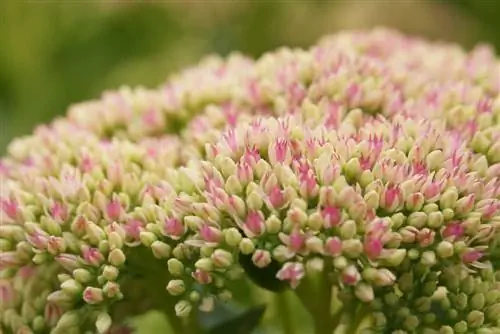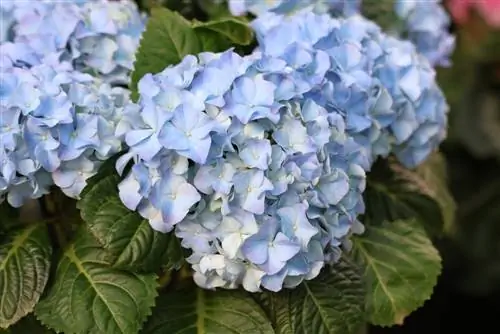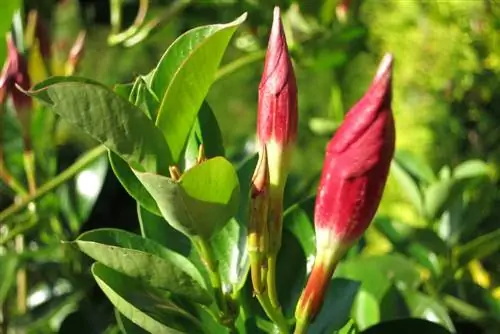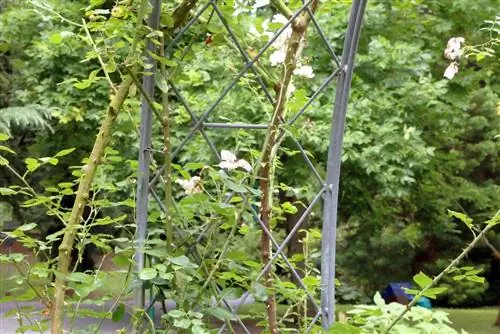- Author admin [email protected].
- Public 2023-12-17 03:39.
- Last modified 2025-06-01 06:48.
Are withered flowers, long stunted shoots and misshapen habits a thorn in your side? Then get your fat hen back into shape with a skillful pruning. The bizarre, striking growth of the popular garden and house plant raises questions about timing and pruning. These instructions explain in 5 steps when and how to cut stonecrop correctly.
Step 1: Choosing a date - when is the best time?
When sedums bathe the garden, balcony and windowsill in a sea of color in late summer, no one thinks about cutting them back. In fact, the diverse species and varieties retain their decorative appeal well into winter. It is the shapely seed heads that create eye-catching accents indoors and outdoors during the cold season.
For the hardy survivors within the genus, withered flowers and seed heads also act as natural protection against frost and snow. So that a fat hen can overwinter undamaged, the time window for pruning does not open until early spring. The following dates have proven themselves in practice:
- Houseplant: in March
- Bedding plant in winter quarters: before clearing out in April
- Garden plant: in good time before the fresh shoots - between the end of March and the beginning of May, depending on the region
Pruning sedums outdoors is ideally done on a dry, frost-free and overcast day. The magnificent thick-leaved plants have a soft spot for sunny locations. Of course, the fat hen does not want to be cut under the influence of direct sunlight.
Tip:
Frost-sensitive sedums in balcony boxes or pots ideally overwinter in bright, frost-free winter quarters. From November to February, the succulents stay at 5 to 10 degrees Celsius and stop growing completely. During this time, care is limited to a small sip of water now and then so that the substrate does not dry out completely.
Step 2: Preparatory work
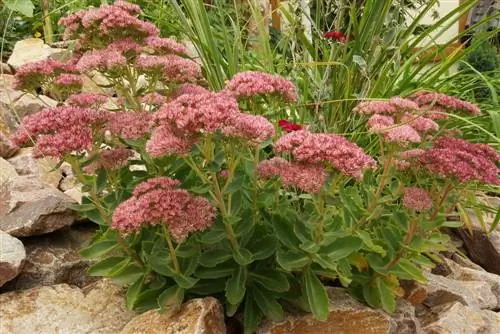
A fat hen should be spared from unsharp scissors and dirty blades. Frayed cuts offer pathogens and pests ideal areas to attack. In most cases, the pathogens are already lurking on the cutting edges if they have not been cleaned after pruning infected plants. Please pay particular attention to the following preparatory work:
- Sharpen the blades of scissors or knives
- Pick up a clean cloth or kitchen fleece
- Moisten with spirit or high-percentage alcohol
- Wipe the cutting tools thoroughly
Provide pieces of paper towels or Tempo tissues to stop the flow of sap on houseplants before it stains the windowsill or floor. It is also advisable to wear gloves. The plant sap is slightly toxic and can cause allergic reactions if it comes into contact with the skin.
Step 3: Thinning
Tall sedums, such as Sedum spectabile or Sedum telephium, can reach majestic heights of up to half a meter. Sometimes some of the numerous species and varieties tend to become woody and bald. The third step in this guide is intended for these plants to free them from ballast. How to do it right:
- Cut off woody, old shoots at the base
- Thinning out bare branches from below
- Remove weak, thin shoots close to the ground
This approach aims to create a light-flooded fat hen whose shoots are covered in foliage from base to tip.
Step 4: Shorten shoots
In 2011, the Association of German Perennial Gardeners named Fette Henne Perennial of the Year for the second time. The plant owes this title to its magnificent appearance, which hardly requires any care. If planted correctly in a sunny location, fertilizing and watering are of secondary importance. It is also your individual decision whether you cut back the shoots at all or just clean out the withered flowers. Experience has shown that bushy, compact growth is promoted by targeted pruning. This cut guarantees a perfect result:
- Clean out all withered flowers or seed heads in early spring
- Cut back shoots that are too long by one to two thirds
- Ideally cut a few millimeters above a leaf or bud
- Cover cuts with heavy sap flow with a piece of fleece
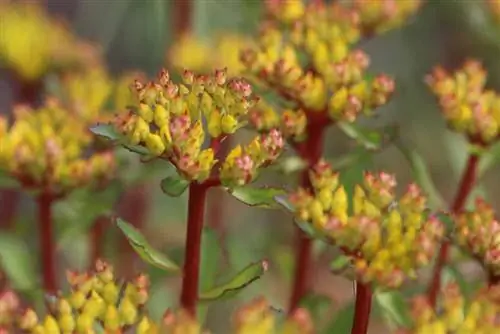
A topiary cut is particularly recommended if a fat hen develops long, thin shoots and falls apart. This unnatural length growth occurs primarily during the dark season when stonecrops overwinter on the windowsill as houseplants. Under the influence of normal room temperatures and lack of light, long, thin fear shoots form. The damage can be remedied by immediately changing the location to a bright, slightly temperate room and cutting back to the he althy area of the affected shoots. If the right winter quarters are not available, compensate for the lack of light with a daylight lamp.
Step 5: Repotting and root cutting
Overwintering, cutting and repotting go hand in hand when caring for sedums. This applies equally to house and balcony plants. If you leave it at pruning, the stressed plant will lack enough energy for fresh growth. Therefore, unpot the fat hen and remove the leached plant soil.
Examine the substrate-free root ball closely for damaged or dead roots. You can cut out the strands with sharp scissors. Finally, pot the plant in fresh succulent soil enriched with lava granules. Commercially available potting soil is too nutrient-rich for sedums and causes fattening growth. In a lean substrate with a pH value of 6.5 to 7.3, the plants develop a compact, stable habit.
After the care measure, treat the exotic potted plant to a phase of regeneration. For this purpose, assign your stonecrop to a partially shaded, warm location. Since fresh substrate is usually pre-fertilized, do not apply fertilizer. The plant is now grateful for a sip of soft water.
Tip:
Sedums are suitable for virtuoso creations that are unique in the plant kingdom. The thick-leaf plants showcase their striking silhouettes in old shoes, old zinc tubs or antique porcelain bowls. A little earth and a water drain are enough for the furious fireworks of colors and shapes to unfold.
Special case of vase cutting - How to cut flower stems for the vase correctly
The magnificent sedum and other tall species are suitable for a vase cut. Cut the stems when the flowers have just opened. Placed in fresh water, the impressive bouquet spreads its exotic flair for several weeks. When cutting the vase, place the scissors one to three finger-widths above the ground. As long as at least one eye remains on the shoot, the fat hen will happily sprout again.

